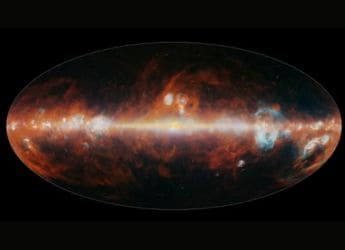- Home
- Science
- Science News
- Hubble Space Telescope Spots Farthest Individual Star Ever Seen
Hubble Space Telescope Spots Farthest Individual Star Ever Seen

Photo Credit: NASA, ESA, and P. Kelly (University of Minnesota)
Setting a new distance record, astronomers using NASA's Hubble Space Telescope have discovered an enormous blue star nicknamed "Icarus", the farthest individual star ever seen.
They also used Icarus to test one theory of dark matter and to probe the make-up of a foreground galaxy cluster, the US space agency said on Tuesday.
"This is the first time we're seeing a magnified, individual star. You can see individual galaxies out there, but this star is at least 100 times farther away than the next individual star we can study, except for supernova explosions," explained Patrick Kelly, study leader from University of Minnesota, Twin Cities.
The star, harboured in a very distant spiral galaxy, is so far away that its light has taken nine billion years to reach Earth.
Icarus, whose official name is "MACS J1149+2223 Lensed Star 1", is only visible because it is being magnified by the gravity of a massive galaxy cluster -- located about five billion light-years from Earth.
In gravitational lensing, gravity from a foreground, massive cluster of galaxies acts as a natural lens in space, bending and amplifying light.
The discovery of Icarus through gravitational lensing has initiated a new way for astronomers to study individual stars in distant galaxies.
These observations provide a rare, detailed look at how stars evolve, especially the most luminous stars, NASA said.
Detecting the amplification of a single, pinpoint background star provided a unique opportunity to test the nature of dark matter in the cluster.
Dark matter is an invisible material that makes up most of the universe's mass.
When NASA's James Webb Space Telescope is launched, astronomers expect to find many more stars like Icarus.
"Webb's extraordinary sensitivity will allow measurement of even more details, including whether these distant stars are rotating. Such magnified stars may even be found to be fairly common," NASA added.
Get your daily dose of tech news, reviews, and insights, in under 80 characters on Gadgets 360 Turbo. Connect with fellow tech lovers on our Forum. Follow us on X, Facebook, WhatsApp, Threads and Google News for instant updates. Catch all the action on our YouTube channel.
Related Stories
- Samsung Galaxy Unpacked 2025
- ChatGPT
- Redmi Note 14 Pro+
- iPhone 16
- Apple Vision Pro
- Oneplus 12
- OnePlus Nord CE 3 Lite 5G
- iPhone 13
- Xiaomi 14 Pro
- Oppo Find N3
- Tecno Spark Go (2023)
- Realme V30
- Best Phones Under 25000
- Samsung Galaxy S24 Series
- Cryptocurrency
- iQoo 12
- Samsung Galaxy S24 Ultra
- Giottus
- Samsung Galaxy Z Flip 5
- Apple 'Scary Fast'
- Housefull 5
- GoPro Hero 12 Black Review
- Invincible Season 2
- JioGlass
- HD Ready TV
- Laptop Under 50000
- Smartwatch Under 10000
- Latest Mobile Phones
- Compare Phones
- Huawei Nova 15
- Huawei Nova 15 Pro
- Huawei Nova 15 Ultra
- OnePlus 15R
- Realme Narzo 90x 5G
- Realme Narzo 90 5G
- Vivo S50 Pro Mini
- Vivo S50
- Asus ProArt P16
- MacBook Pro 14-inch (M5, 2025)
- Huawei MatePad 11.5 (2026)
- OnePlus Pad Go 2 (5G)
- OnePlus Watch Lite
- Just Corseca Skywatch Pro
- Acerpure Nitro Z Series 100-inch QLED TV
- Samsung 43 Inch LED Ultra HD (4K) Smart TV (UA43UE81AFULXL)
- Asus ROG Ally
- Nintendo Switch Lite
- Haier 1.6 Ton 5 Star Inverter Split AC (HSU19G-MZAID5BN-INV)
- Haier 1.6 Ton 5 Star Inverter Split AC (HSU19G-MZAIM5BN-INV)

















